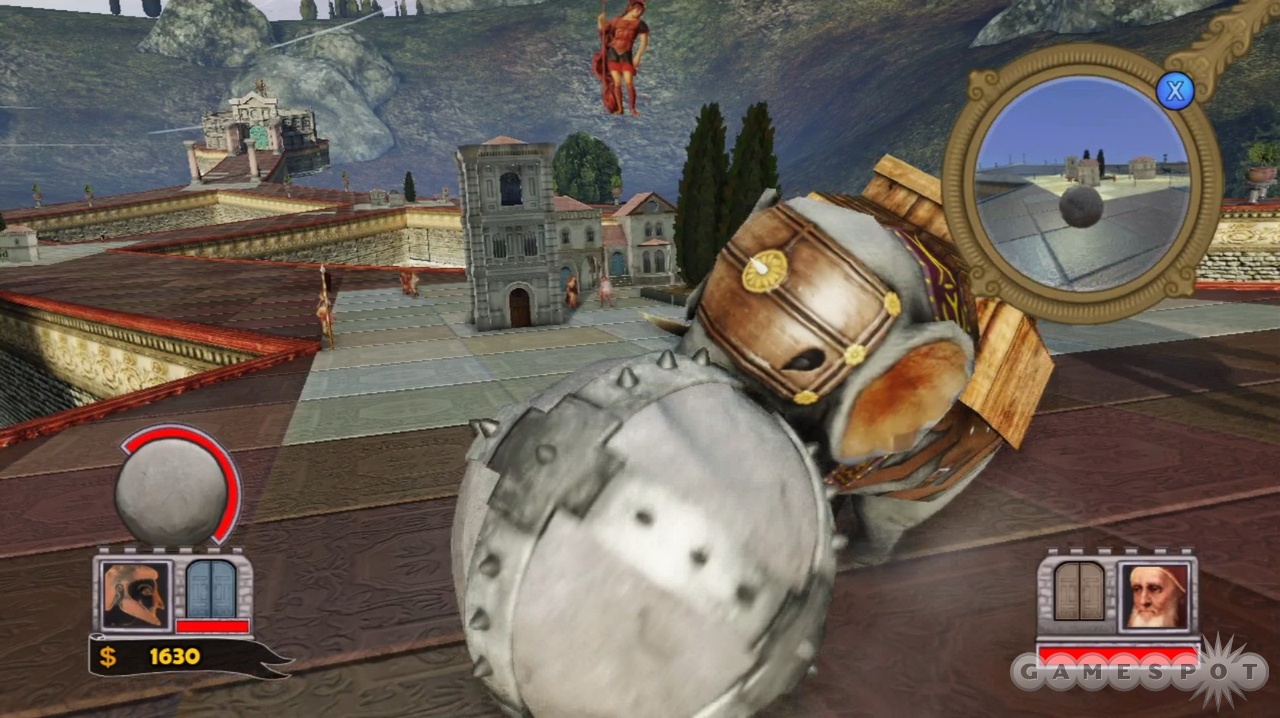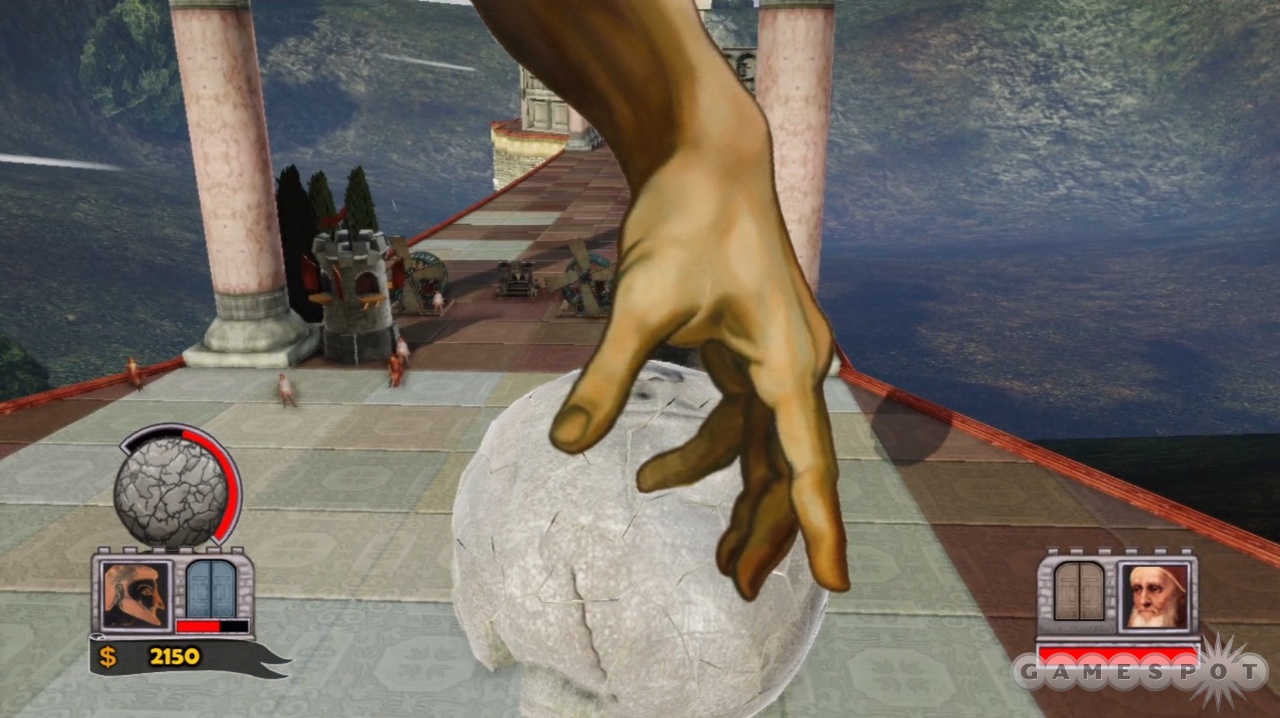Poor Sisyphus. For his trickery and arrogance, he was sentenced by the gods to roll a boulder up a hill, only to see it roll back down. Then he had to repeat this grueling and pointless task over and over again for all eternity. At least, that's the official version. But who could endure such a fate? Surely, the temptation to harness the power of that rolling boulder and break free of captivity would be too great to resist. In Rock of Ages, Sisyphus makes lemonade out of lemons, using his giant rock to escape the underworld and set off on a journey that sees him clashing with some of history's greatest leaders and conquerors. In this spirited game of assault and defend, it's enjoyable to smash into and roll over the opposition. But the defensive elements of the game don't pull their weight, making this boulder's journey throughout history a woefully uneven one.
The tale Rock of Ages tells is gleefully nonsensical, with cutscenes before each of the game's 23 single-player stages that thrust Sisyphus into conflict with another personage, either historical or mythical. These cutscenes irreverently weave historical events and pop-culture references in ways that are always lighthearted and may occasionally make you chuckle. The game's visual style, which takes obvious inspiration from the work that Terry Gilliam did as an animator for Monty Python segments, uses images taken from classical paintings and other works of art to represent Marie Antoinette, Bacchus, the Great He-Goat, and everyone else you encounter on your adventure. This look gives the entire game a whimsical vibe that's an ideal fit for the goofy gameplay in Rock of Ages.
The main mode, which you play again and again throughout the game's story, is called War. It takes place on long, narrow, frequently winding battlefields with castles on either end. In one castle resides your chosen commander (Sisyphus, if you're playing through the story), and in the other hides the enemy leader. During one phase of play, you take direct control of a boulder. Your goal is to roll the massive rock right into the enemy castle's sturdy gates, damaging and eventually destroying them. Once you destroy the gates, you can use your boulder to unceremoniously "defeat" the helpless enemy commander before he or she defeats you. Navigating the twisty path to the enemy castle can be a bit tricky, but if you fall off the edge due to your own clumsiness or to an effective strike from your opponent's defenses, the hand of God (or a god, anyway) places you back on the field. Still, the few seconds this costs you can mean the difference between victory and defeat. The boulder has an appropriate sense of weight to it; it's slow to get moving but can build up tremendous speed and momentum when it rolls downhill. It can also leap into the air, which is useful--a little too useful--for avoiding the defenses your enemy has placed in your path.

Each time you crash your boulder into the enemy's gates (or your boulder gets so damaged that it crumbles to bits on the way down), your workers get busy hewing a new one out of a giant stone cube. During this downtime, you can set up defenses to make the enemy boulder's path to your gates more treacherous, while your opponent establishes defenses on the other side of the field. The problem is that these defenses often have little or no impact on your opponent's assaults, and the defenses you encounter on your runs rarely do much to hinder you. Defensive units cost gold, which you earn by destroying domiciles, vases, and other objects on your destructive tear toward the enemy castle, and, later in the game, by building mines. The units take up a certain number of tiles on the field as well, turning the lighter tiles on which you're allowed to build defenses into darker tiles on which you're not. For instance, a siege tower only uses the single space it's placed on, allowing you to build a solid row. But war elephants, which can charge into and damage enemy boulders, take up 21 tiles, preventing you from placing them too close together.
But no matter how you place your defenses, it's unlikely that their efforts will be successful. Catapults and trebuchets tend to miss the mark by a wide margin; explosive barrels can be leapt over easily; and mammoths react so slowly that, as long as you're moving at a reasonable speed, you can roll past them before they get near you. Defenses are also hamstrung by the fact that you can only set them to face one of four directions, and very often, none of those are the most useful. Furthermore, the cursor you use to place units moves quickly. As a result, if you're trying to, say, build a barricade of siege towers, you might lose a few seconds just trying to get the cursor to highlight the right tiles. Not that your efforts are likely to matter much. On occasion, your opponent might be blown off course by one of your fans or your boulder might be damaged by a ballista blast, but most defenses prove to be ineffectual. You can watch your enemy's boulder make its approach to your castle via a picture-in-picture window, and seeing the boulder roll unhindered past your defenses while you speed past the enemy's makes the defensive phase of the game feel like something of a waste of time.
Conflicts also start to feel predictable once it becomes apparent that they almost always boil down to who can make three runs on the enemy's gates first. If your boulder takes damage en route to the enemy castle, it may be smaller and do less damage, but on your third assault, it's very rare that it won't do enough damage to shatter the gates. This means that close races for that third and final strike can create nail-biting moments, but when one player gets a decent lead on the other, the outcome becomes all but a foregone conclusion because your defenses are unlikely to hinder your opponent long enough to give you a chance to catch up.
The campaign's 23 stages only take a few hours to complete, but the game doesn't feel too short. Each stage takes place on a new battlefield and introduces a new unit into your defensive arsenal, but the predictability of the action means it falls into a rut before it ends, and simply making the game longer wouldn't have improved the experience. Sprinkled throughout the story are also a few boss battles, but while they look impressive and are conceptually amusing--in one, for instance, you battle a massive version of Michelangelo's David--they're boring to play. Once you figure out the path that lets you roll or fling your boulder into the boss's weak spot, victory is a simple matter of repeating the process three times.
War can be played online or via split-screen against a human opponent, but the same issues that impact the single-player game apply. It's fun for a little while to race to see who can be first to score that all-important third impact on the enemy gates, but the weakness of the defensive aspect keeps these battles from being altogether engrossing. The other competitive mode is called SkeeBoulder. Here, you and your opponent race to the end of a battlefield, smashing targets along the way to score points. At the end awaits a ramp and a skeeball-like panel with boulder-sized holes that convey a score multiplier to the player who gets his or her boulder into one first. This mode gives one player an advantage on certain courses by giving him or her an inside line on the track. Regardless of which battlefield you select, SkeeBoulder is too shallow to hold your interest for long.

The same can be said of the Time Trial mode, in which you earn medals by racing to the end of a battlefield within a set amount of time. The boulders are fun to smash things with, but they're not fun to race, so this mode doesn't play to the game's strengths. In fact, too much of Rock of Ages doesn't play to its strengths. A rolling stone gathers no moss, but this stone spends too much of its time not going anywhere.